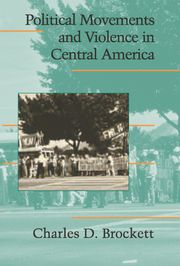Book contents
- Frontmatter
- Contents
- Figures, Tables, and Maps
- Abbreviations and Acronyms
- Acknowledgments
- 1 INTRODUCTION
- Part One From Grievances to Contentious Movements
- Part Two Opportunity, Contention, and Repression
- 6 CYCLES OF CONTENTION
- 7 CHANGING POLITICAL OPPORTUNITIES AND CONTENTIOUS CHALLENGERS: GUATEMALA
- 8 CHANGING POLITICAL OPPORTUNITIES AND CONTENTIOUS CHALLENGERS: EL SALVADOR AND CENTRAL AMERICA
- 9 CONTENTION AND REPRESSION: GUATEMALA
- 10 CONTENTION AND REPRESSION: EL SALVADOR
- 11 CONCLUSION
- References
- Index
6 - CYCLES OF CONTENTION
Published online by Cambridge University Press: 23 November 2009
- Frontmatter
- Contents
- Figures, Tables, and Maps
- Abbreviations and Acronyms
- Acknowledgments
- 1 INTRODUCTION
- Part One From Grievances to Contentious Movements
- Part Two Opportunity, Contention, and Repression
- 6 CYCLES OF CONTENTION
- 7 CHANGING POLITICAL OPPORTUNITIES AND CONTENTIOUS CHALLENGERS: GUATEMALA
- 8 CHANGING POLITICAL OPPORTUNITIES AND CONTENTIOUS CHALLENGERS: EL SALVADOR AND CENTRAL AMERICA
- 9 CONTENTION AND REPRESSION: GUATEMALA
- 10 CONTENTION AND REPRESSION: EL SALVADOR
- 11 CONCLUSION
- References
- Index
Summary
Popular movements achieved historic successes in 1944 in both El Salvador and Guatemala. Long-term dictatorships were brought down in both countries by nonviolent campaigns involving thousands of people that continued day after day. Jorge Ubico fled Guatemala on July 1, ending thirteen years of tyranny. In El Salvador General Maximiliano Hernández Martínez left power on May 9 in the face of “the most impressive” civic strike in Latin American history (Ackerman and DuVall 2000, 260). His tight-fisted rule also began in 1931, but in his case was consolidated with a massacre in January 1932 of some ten to thirty thousand peasants and suspected leftists following their aborted uprising. After this 1944 peak of popular success and jubilation in both El Salvador and Guatemala, however, the trajectories of popular movements in the two countries differed sharply for the next decade and a half.
In Guatemala Ubico's successor soon was forced to flee as well during the “October Revolution” of 1944, which ushered in ten years of progressive government. First under the reformist Juan José Arévalo and then under the more radical Jacobo Arbenz, government responded to popular aspirations and facilitated labor and peasant organizing. But this experiment in popular rule was doomed by the Cold War. There was communist influence in Arbenz's administration, provoking the overthrow of his popularly elected government in 1954 by the combined forces of the Guatemalan right and the U.S. government. Under the new military regime, popular mobilization was crushed – for a time.
- Type
- Chapter
- Information
- Political Movements and Violence in Central America , pp. 169 - 193Publisher: Cambridge University PressPrint publication year: 2005

